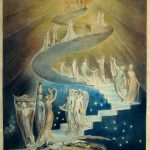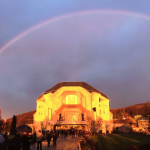PETER TREADGOLD
A Tribute to Peter Treadgold
Lacquanna Paul
“A Mind on Fire”
We first met Peter back in the fall of 1996 in Kinsau, Germany. I, among seven other eager Americans, had come together for a two-month training in cosmic dance, untrained both in the art of eurythmy, as well as in star gazing, we were pretty much virgin territory, but hearty nonetheless in our quest to discover the starry heavens through the eurythmic movement of their dancing forms.
Peter arrived about at the halfway point in our training and we greeted him with the happy hearts that had been tenderized through our daily activities. Peter had come to help Robert with the intricacies of Astro, which was Peter's computerized version for an astrosophy tool which he had developed over many years. But the real meeting, I believe, was for us to meet Peter, whom I recall we just instantly loved.
He was majestically tall, graceful and noble in his bearing. His speaking was full and resonant with a sounding intelligence, which we drew upon as much as we could. The meeting was also important for Peter, and he even spoke this out, that something about our American exuberance had set him free. And it was this that seemed central to his being the endeavor to free that which was ignited within him: a burning passion for the realization of the. This came poignantly to light one evening in a conversation about working in collaboration with the spiritual world. Apparently, Peter had experienced this in a working relationship with a colleague, lasting over a span of seven years, and he longed for this again and knew it as a potential for every human endeavor. As I recall, the conversation lasted until the wee morning hours, and I remember the fire in his eyes and the longing. And so it came as a shock when Peter wrote soon thereafter that he had been diagnosed with cancer.
He came again the following year and shared how he had taken up Rudolf Steiner?s advice, as a healing agent, to observe the sunrise each morning, which for Peter meant a drive of some distance in order to have this encounter. He did this over many months and described having had a true sunrise in his soul, an inner experience of what could only be described as joy. And, as though having received a gift from the Sun, he shared that he had fallen in love with Eliza, a wonderful Brazilian story-teller whom he had met at a biography conference in London, and whom he later married.
Peter's second visit happened to coincide with the graduation of the second cosmic dance training. I remember how he wept as he watched the dances, and how we draped him in the comforting arms of our borrowed silk eurythmy gowns afterward. He was somehow profoundly touched by these moving human forms, which brought to expression an earthly mirroring of the starry heavens which he knew so well.
This has been his collaboration hopefully divinely inspired a collaboration which has left a legacy enabling others to discover these wisdom-filled annals. And I envisage him now enrobed in the folds of Sophia's mantle. Perhaps his name, Peter, beheld the legacy of the archetypal Peter having been given the keys to the kingdom of heaven. Peter sought to develop the keys to the further understanding of the wisdom of the stars, and his daily walk over many years has been the tread to reveal the pure gold of the starry realm.
Peter's longing toward divinely inspired collaboration has been one of true sacrifice. Having suffered the loss of one of his legs at the age of 19, it seemed that the bulk of his life forces had been lifted to the fiery mental realm. His choleric nature has peppered his relationships with colleagues over the years, largely due to the frustration of his situation. His was a fiery protest even unto the end! Much like Beethoven, who through the loss of his outer hearing came into a more profound encounter with the music of the spheres, Peter?s physical losses predestined him toward sedentary work and the fire of his was in collaboration with the mysteries of our cosmic origins.
Footnote by Robert
It is with deep and profound gratitude that I look back upon the treasured memories of Peter, whom Lacquanna (Lucky) has described so well in her above account. I would love to add more to honor the great individuality who lived on Earth as Peter Treadgold. It is my hope that someone will write an in-depth biographical account outlining Peter's most interesting and fruitful life and capturing something of his radiant spiritual essence. My contribution following is not so much about Peter but about his creation, Astrofire, which is his great gift to humanity. In this contribution, I have included Peter's own words concerning Astrofire, his baby, as he expresses it so as to allow Peter's voice to speak, to convey to us his vision of Astrofire. And it is to honor Peter's great spirit and his unique gift to humanity that the following is intended.
The star world now is flowing,
As living, golden wine,
Its joys on us bestowing,
Ourselves as stars will shine.
(Novalis)
Peter Treadgold (1943-2005)
Peter will be remembered as the creator of Astro and Astrofire, the computer programs he wrote for research into Astrosophy (star wisdom).[i] These programs are used by many researchers around the world and Astrofire, in particular, is a far-reaching creation opening up extraordinary possibilities for research containing a database of birth and death dates of historical personalities as well as a star catalog with over 4000 stars.
Work began on developing these programs back in 1973 when Peter received an early primitive version? of such a program. It was at this time that our collaboration, continually inspired by our common interest in the work of Willi Sucher, began ? and it extended for more than thirty years. This collaboration was first made visible through the publication of our booklet The Sidereal Zodiac,[ii] in which Peter helped with various computations ? for example, finding the exact boundaries of the zodiacal constellations as defined by the International Astronomical Union in 1928.[iii] The collaboration continued through the years with the publication of the yearly Christian Star Calendar, for which Peter computed the ephemeris.[iv] Our final collaboration was on Astrofire ? to which I contributed the database of births and deaths of historical personalities[v] - and on my Ph.D. thesis on the History of the Zodiac, to which he contributed the computation of the latitudes and sidereal longitudes of 1022 stars for the reconstruction of the ancient Babylonian star catalogue.
Peter worked on developing Astro ? and then Astrofire ? for a great many years. The inspiration for creating these programs came through his contact with Willi Sucher (1902-1985), who pioneered Astrosophy.[vi] In Peter?s own words (from Help Topic #1 of the Astrofire program):
Back in the early 1970s, seeing how Willi Sucher had to calculate the positions of the planets from tables by hand (a process which could take up to half an hour for each chart), I had the impulse to computerize these calculations for him. Things were not so easy, as there were no PC's or VDU?s and computers were the sizes of rooms. None the less, I managed to print out various ephemerides. My dream, of course, was to be able to do what Willi was doing by hand, the ultimate aim is to reproduce his prenatal charts.
With the advent of home computers in the 1980s, things started to look promising, but it was not until the advent of Windows and Visual Basic that it looked as if I could realize my dream. And so it was in the 1990s, more than twenty years later, that I launched my first program Astro. The intervening years were full of sporadic activity as I learned how to calculate the planetary positions, astrological houses, etc. And with each new type of PC, I improved my old main-frame computer program. Willi often demonstrated the lemnicentric motion of the Sun and Earth using people and although he could make no calculations, it obviously fired his imagination? It needed only a few lines of code to reproduce this lemnicentric motion in the computer. So Astro hit the world with not only the geocentric and heliocentric motions of the planets but the lemnicentric as well.
Now, Willi had another impulse, which was comparing the charts of living people with the charts (both birth and death) of important historical personalities?I have therefore included in Astrofire a comprehensive option to look for similar charts in a database of charts. Just as I expanded Willi?s prenatal work considerably in Astro with the Astrological Biography, so I have done the same in Astrofire with a feature I call Similars. Of course, this feature would be worthless without a database of historical personalities, and for this very purpose Robert Powell has developed one containing over 2000 birth and death charts. You can, of course, add new personalities and even create databases of your own. It's a big new feature and one I know some people have long been waiting for.
Astro has an option to print charts with some of the zodiacal stars around it with lines joining some of them. This chart fired the imagination of many people and in Astrofire I have taken the use of the stars much further. To help you use the program, you will find that there is an enormous file on the program CD called Training Videos. This contains a number of videos in which I guide you painlessly through each aspect of the program. Once again: Welcome to Astrofire.
In Peter's own words from his article Astrofire is a Work of Art, written in October 2004:
To me, Astrofire is a very profound spiritual vision which I have been in the process of creating over many years. Now, an artist has to choose his medium, and just as the sculptor might choose stone or metal, the author a book or tape, so I chose the computer. This means that my relationship with Astrofire is similar to that of the sculptor with his sculpture and the author with his book, and I am just as sensitive to my baby as they would be to theirs. You see, Astrofire is a finished creation and should be able to flourish on its own - if it were not for one thing, and that one thing is computer illiteracy. It is hopefully true that anybody can become computer literate and it is also true that it is much easier for some than for others. There are a few new words to learn but fundamentally it is learning new concepts, skills, and ways of doing things. For many, we are talking about retraining and the development of a new faculty while for others it is just a question of learning. The key ingredient for all is interest. Now, in writing Astrofire, I have tried to make the program as easy to use as possible - consistent with its fairly advanced features. As I said, Astrofire is a finished work of art which is currently being used by more than 50 people around the world. I use the word "finished" as an author or a film director would use the word. No doubt all of us could improve our work but I feel that Astrofire is finished and that it reflects the vision I have of enabling the followers of Willi Sucher to confirm his work and to enable it to be developed further. My program gives expression to cosmic realities which have the potential of being read by the user. As far as I'm concerned, Astrofire is a finished and reliable work of art which is my contribution to the work of Willi Sucher.
Those users of Astrofire who are doing research in the field of Astrosophy (star wisdom) will know what a remarkable instrument Peter has created. In relation to Sophia, Divine Wisdom, perhaps it is interesting to know the origin of the name Astrofire ? as described by a great Russian poet and seer in one of his visions. This seer, Daniel Andreev (1906-1959), beheld Sophia (whom he calls Zventa Sventana) descending from the ?heights of our universe?, i.e. from the realm of the galaxy with its great center:
I vaguely remember seeing a glowing mist of stunning majesty, as though the creative heart of our universe had revealed itself to me in visible form for the first time. It was Astrofire, the great center of our galaxy.[vii]
The practical application of Peter's program Astrofire for astrosophical research is one level. Another level is that this program is intended as an instrument to enable us to become ever more aware of the majesty of the starry heavens and of the Ultimate Source of all existence: ?the great center of our galaxy, the creative heart of our universe?. In the words of Ludwig van Beethoven (1770-1827) who, on one of his walks, passing by a beautiful place, once said:
I often sit here for hours on end and my senses feast on the sight of the offspring of Nature receiving and proliferating. Here there is no roof made by human hand hiding the majestic Sun from me the blue sky is my sublime roof. In the evening, when I contemplate in awe and wonder, beholding the host of vibrant points of light named suns or stars visible within heaven's boundaries - then my spirit soars beyond the distant stars to the Ultimate Source from which everything created streams and from which eternally new creations will stream forth.[viii]
It is in this spirit that we can now think of Peter, who has returned to the world of stars, having died peacefully into Sophia?s loving embrace at 10:15 a.m. on Saturday, April 30, 2005, in Madrid. He passed on when the Sun was located at 15½° Aries in the sidereal zodiac, exactly where it stood at the event of the resurrection of Jesus Christ that took place 1972 years previously (on Sunday, April 5 in A.D. 33). Released from the earthly body, his youthful being is as if resurrected. Now he is experiencing the world to which he dedicated his spirit? experiencing the starry heavens from within, as his new home, after his creative and fruitful 62-year sojourn on the Earth.[ix]
[i] ?Astrosophy: A brief overview of current research with particular reference to the astrosophical research program Astrofire,? Christian Star Calendar 2005 by Robert Powell and Peter Treadgold (Sophia Foundation of North America: Eugene/Oregon, 2004), pp. 7-21. The Astrofire program is available from the Sophia Foundation, www.sophiafoundation.org.
[ii] Robert Powell and Peter Treadgold, The Sidereal Zodiac (American Federation of Astrologers: Tempe/Arizona, 1985).
[iii] Ibid., p. 32.
[iv] Robert Powell and Peter Treadgold, Christian Star Calendar (Sophia Foundation of North America: Eugene/Oregon, yearly). From 1991 to 2001 Michael Brinch was responsible for computing the ephemeris in the Christian Star Calendar
[v] It is appropriate to mention here that Wain Farrants of Botton Books, England, gave Peter a great deal of help in the testing and designing of Astrofire.
[vi] Willi Sucher, Cosmic Christianity & the Changing Countenance of Cosmology (SteinerBooks: Gt. Barrington/ Massachusetts, 1995) includes an excellent biography of Willi Sucher by Jonathan Hilton. Other works by Willi Sucher are available from the Astrosophy Research Center, P.O. Box 13, Meadow Vista, California 95722, USA.
[vii] Daniel Andreev, The Rose of the World (Lindisfarne Books: Gt. Barrington/Massachusetts, 1997), p. 198.
[viii] Jochen Kirchhoff, Klang und Verwandlung (Kösel Verlag: Munich, 1989), p. 164.
[ix] Peter was born at 4:00 a.m. on Saturday, February 20, 1943, in Minchinhampton, England.




